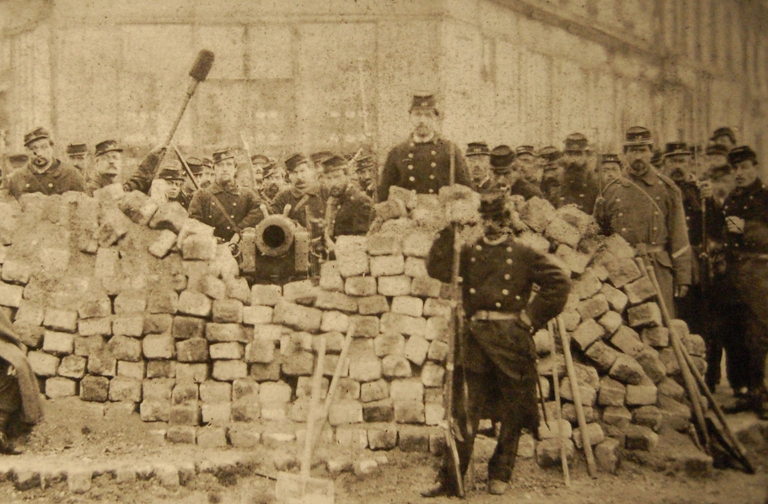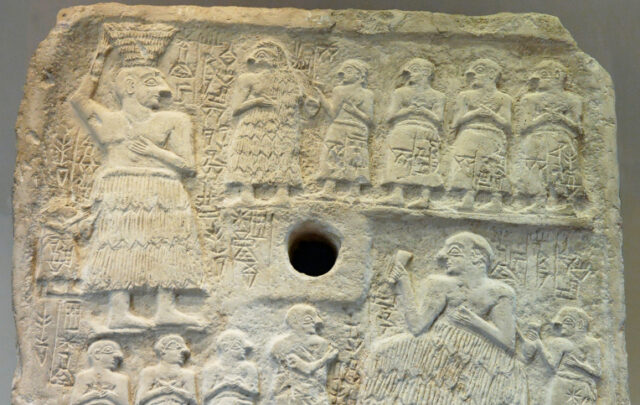In March 1871, as the second French empire disintegrated, women, workers, and members of the National Guard (a citizen neighbourhood militia) of Paris erected barricades and occupied government buildings across the capital. Although the Paris Commune, as it came to be known, lasted just 72 days, it achieved some major reforms: the death penalty, conscription and child labour were abolished, debts were cancelled or postponed, and the communards established a women’s union, producer-owned cooperatives and a secular school system. The elected rulers took a worker’s wage and were actively building what communard Paschal Grousset later called ‘the republic of our dreams… democratic and social… a precision instrument of economic transformation’.
By 28 May, the experiment with self-organisation and municipal democracy had been violently repressed. Yet the experience of Paris has come to inspire many different political movements and numerous theorists claim ‘the Commune’ as their own.
The most well-known account is that of Karl Marx, who saw the Commune as the first successful attempt to establish a ‘dictatorship of the proletariat’ – a reading that is later echoed in Lenin’s famous pamphlet State and Revolution (1917). The Russian anarchist Mikhail Bakunin, on the other hand, saw it not as an example of a transitional government, but rather as a short-lived prefiguration of the future, stateless and classless, society itself.
This appropriation of the Commune has continued over the past 150 years: from the council movement in inter-war Germany to the situationists and soixante-huitards (May ’68ers) in France, and contemporary municipalists. A 20th-century radical tendency, spearheaded by the US theorist Murray Bookchin, even referred to itself as ‘communalism’.
Why has the Commune inspired so many different movements and tendencies? How could this idea be transferred between so many different social, political, cultural and economic contexts?
Communal inspiration
A major reason for the lasting status of the Commune is its experimental character. As Marx concluded in his account, ‘The working class cannot simply lay hold of the ready-made state machinery, and wield it for its own purposes.’ Instead, Parisians had to establish their own ‘social republic’ with its own institutions and procedures.
In her influential book Communal Luxury, Kristin Ross presents the Commune as a ‘laboratory’ in which common people could try out a radically different, more democratic society. These political experiments included general male suffrage, federalised forms of organisation and political representation on the basis of instant recall and imperative mandates. They were not limited to the formal institutions of the Commune: each arrondissement in the city had its own vibrant social and revolutionary clubs, where workers and intellectuals exchanged ideas and experiences. But it was arguably in their everyday lives as workers and citizens that Parisians experienced the greatest transformations. The Commune was, to use a modern term, a prefigurative experiment, even though there were very different conceptions of what exactly was to be prefigured.
This brings us to the second point: already, before its proclamation, the idea of the Commune was open to dispute. John Merriman, in his excellent book Massacre: The Life and Death of the Paris Commune argues that from its beginning it took on ‘different meanings to different people, depending on their allegiances’. This is so, in part, because the short-lived commune of 1871 was not the first ‘Paris Commune’. Its name invoked the mythicised memory of another insurrectionary Parisian government established during the French revolution in 1792.
As a consequence, there were many different (and often vague) ideas of what the Commune should stand for, whose interests it should serve, what institutional or procedural form it should have, and who was to lead it and how. According to Ross, the Commune was ‘a powerful mix of pre-capitalist and pre- or extra-national desires, equal part social revolution, local autonomy and the memory of the insurrectionary Commune’. To use another modern term, it served as what Ernesto Laclau calls an ‘empty signifier’, establishing links between various demands or identities and uniting different political agendas.
In relation to the third point, the Commune belongs to everyone and to no one in particular. It had strongly localist characteristics, yet at the same time it was internationalist and universalist in spirit. Many foreigners as well as French people took part, and ultimately the ideal was to establish a federalised network of similar communes across the country and beyond. As one communard reflected 26 years later: ‘We didn’t only want to obtain municipal freedoms. If we had emerged victorious we would have organised the revolutionary movement throughout France.’ Indeed, similar attempts to establish a commune were made in Lyon, Marseille, Narbonne, Saint-Étienne and other towns.
Finally, the Commune combined various forms of political organisation. While it promoted participatory democracy, satisfying a desire for more active involvement in politics, it also gave rise to new forms of political representation and institutional reform. Of course, there was often a tension between these aspects. Many Blanquists (who advocated a conspiratorial, tightly-organised approach to revolutionary change) and anarchists (including the communard Louise Michel, who came to believe that the existing order had to be destroyed before a new one could be built) in retrospect felt it should have rejected parliamentarism. Nevertheless, the idea of the Commune was powerful enough to unite these various factions behind it until the end.
Communalism today
Today, the idea of the Commune is still a source of inspiration to various movements, from French municipalists who seek to establish a ‘Commune of Communes’ to the international Fearless Cities movement and the autonomous Kurdish administrations in Rojava. Beyond concrete examples, there is also much to gain from a reassessment of the idea. If we are to understand the radical potential of ‘the Commune’ today, we should not lose sight of its broadness and openness to many different interpretations. Arguably, this productive type of ‘empty signifier’ is precisely what the left often seems to be lacking. So what might a ‘communalist’ politics for the 21st century look like in practice?
One key aspect of communalism is that it crosses the boundary between the local and the global in new and innovative ways. Critiques of globalisation or the EU were once a key feature of the internationalist left. Today, the political debate leaves no middle ground between a neoliberal ‘globalism’ of capital and a reactionary ethno-nationalism (discourses that often serve the same established interests). We need new ways to imagine what a truly anti-capitalist internationalism might look like. The Commune offers a viable alternative, underpinned by an idea of society that is transnational and pluralist, while promoting municipalist or federalist forms of planning and organisation. Seen from a communalist perspective, international solidarity and a focus on local communities may well complement each other.
A communalist approach for the left can also challenge the false dichotomy between electoral-representative politics and participatory democracy. The past decade has seen the emergence of ‘assembly movements’ such as Occupy Wall Street or Nuit Debout. Some of these may have had more discursive impact than is often assumed, but their dismissal of electoral-representative democracy has limited their significance. Though subject to both idealisation and debate, the story of the Paris Commune proves that direct democratic engagement is not incompatible with a coordinated attempt to seize or constitute representative institutions. This is confirmed by recent experiences in Spain, where, in the wake of the 15-M movement, municipalists effectively combined grassroots organisation in urban neighbourhoods with electoral representation at the municipal level.
Finally, a politics inspired by the Commune must seek to combine social and institutional reform. Just as the communards could not ‘simply lay hold of the readymade state machinery’, today’s left cannot simply acquire or employ the instruments of democratic control without radically reshaping them. It is one thing to say that, in its pursuit of hegemony, a left movement needs to be built from the ‘grassroots’ or the ‘bottom-up.’ But it is something entirely different to state that real, institutional change and a redistribution of power must be sought in every aspect of our everyday life: in workplaces, schools and universities, neighbourhoods and municipalities. Seen from a communalist perspective, arguably there is no ‘top’ or ‘bottom’, but rather a plurality of levels on which democratisation can be prefigured on a daily basis. The Commune can still serve as an example of what such a multi-faceted exercise may look like in practice.
The Paris Commune emerged after a catastrophic war in a city under siege. From climate change to the growth of the far right, and from a global pandemic to economic crisis, today’s circumstances again urge us to explore novel political ideas and forms in order to rearticulate and unite the projects of the left. The Commune might be not only ‘the political form at last discovered’ but also, to paraphrase Marx, the political form that is least discovered. A century and a half later, it still appeals to the imagination.
Teaser photo credit: Barricade at the corner of Boulevard Voltaire and Boulevard Richard-Lenoir during the Paris Commune of 1871





